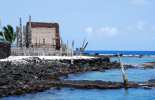Puuhonua o Honaunau Historical Park
Located within the Kailua-Kona Region on Big Island
Founder & certified Hawaii travel expert with 20+ years of experience in Hawaii tourism.
This article may include unbiased affiliate links at no extra cost to you. Mahalo for your support!
Things to Do in Kailua-Kona
Big Island Sacred Sites
Pu'uhonua o Honaunau (poo-oo-ho-noo-ah o hoe-now-now), formerly known as Place of Refuge at Honaunau, is an incredibly beautiful and educational experience that no trip to the Big Island should be without.
After you pay your vehicle fee and walk past the educational displays, you round a corner and are transplanted into the world of the ancient Hawaiians. On this scorched land of sand and lava rock, the ali'i (ruling class) of Hawaii made their home. You can explore how they worked and played underneath the shade of Honaunau's stately palms.
The pamphlet available at the entrance provides explanations for all of the numbered sites on the grounds. One site is a game of konane which was played using pebbles on a stone table. All the structures such as the temple and the huts were carefully recreated using traditional methods. Ti leaves, the multi-purpose plant of the Hawaiians, were used to thatch the roofs, and to make rope and skirts for the hula. The halau, a working structure, shows how the leaves were used and how the double-hull canoes were built and then launched from the small Keone'ele Cove on the grounds.
At the tip of the point, encircled by imposing carved statues with fearsome expressions, ki'i, is the Hale o Keawe where the kahuna prayed and guarded the bones of 23 ali'i. This area is considered to contain much mana, or life force, because of all the powerful rulers who are buried here. The Hale o Keawe is at the end of a great stone wall 10 feet high and 17 feet thick in some places which separates the pu'uhonua or "place of refuge."
Until the 1800s the Hawaiians lived by a strict code of rules called the kapu. Much of those kapus, if broken, were punishable by death. They were explicit. For example, a commoner cannot stand in the shadow of an ali'i and a woman cannot dine with a man. The pu'uhonua was the one sliver of hope for those in violation of a kapu. If they could make it to the sacred grounds before the guards caught them, they could be cleansed by the kahunas and allowed to live. Beyond the Hale o Keawe are more heiau ruins.
You can follow a map provided at the entrance which describes all the sights you will see from ancient games to canoe building and shelters. You can reach the sight by turning makai (toward the ocean) onto Highway 160 near mile marker 104 on Highway 11. Continue down five more miles to the coast on Highway 160.
Great snorkeling is available nearby at Two Step at Keone'ele Cove.
Puuhonua o Honaunau Historical Park Reviews
Guidereview:
A (based on 979 visitor reviews)Geolocation Data
Geographic Coordinates
Latitude: 19.42149154
Longitude: -155.9114229
Hawaii Safety Information
Puuhonua o Honaunau Historical Park Photo Gallery








Recommended Tours Nearby
Affiliate Disclosure: We may earn commissions from some travel partners (like Amazon or Expedia) which helps us maintain this site. These links are at no extra cost to you and don't impact our honest & unbiased recommendations. Remove all the ads →










